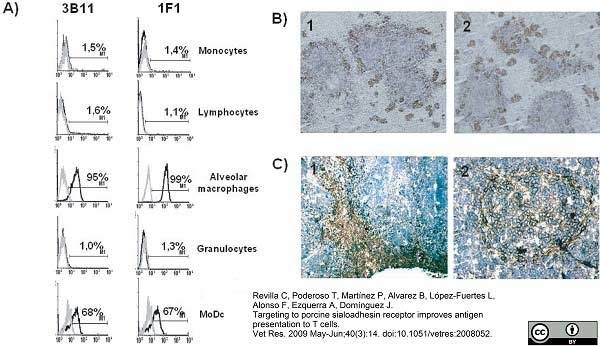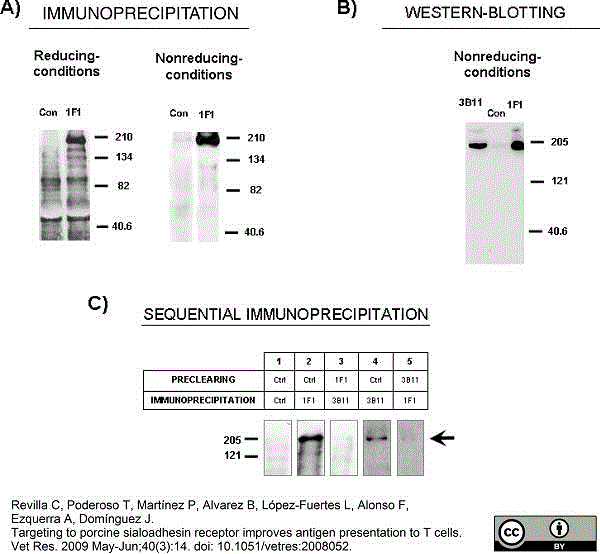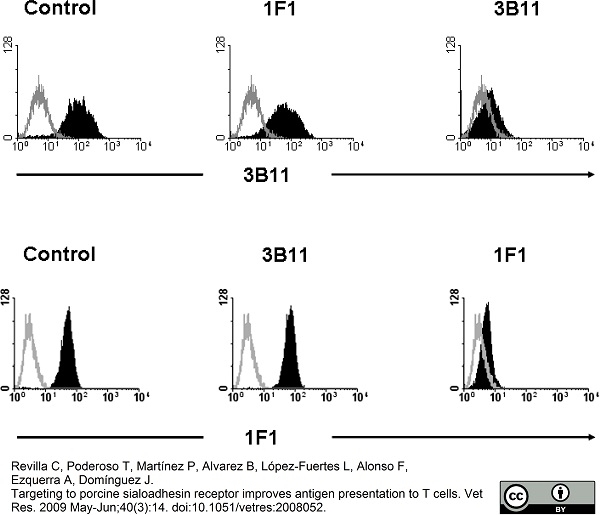CD169 antibody | 3B11/11



Mouse anti Pig CD169:Alexa Fluor® 647
- Product Type
- Monoclonal Antibody
- Clone
- 3B11/11
- Isotype
- IgG1
- Specificity
- CD169
| Mouse anti Pig CD169, clone 3B11/11 recognizes porcine CD169, also known as sialoadhesin or Siglec-1, a member of the sialic acid binding immunoglobulin-like lectin (Siglec) family. CD169 was originally identified in mice and identified as the sialic acid dependent Sheep erythrocyte receptor (Crocker et al.1986). CD169 has subsequently been identified in rat (van den Berg et al. 1992), human (Mucklow et al. 1995) and pig (Vanderheijden et al. 2003) . Mouse anti Porcine CD169, clone 3B1/11 was originally raised as part of a panel of anti porcine macrophage monoclonal antibodies raised against isolated porcine alveolar macrophages (Bullido et al. 1997). Immunohistochemical analysis indicated restriction to macrophage populations mainly in the spleen, lymph nodes, liver and Peyer’s patches. Originally described as a non phagocytic intercellular adhesion receptor, work on porcine CD169 indicated that it may play a role as a viral adhesion receptor (Delputte et al. 2006) and as a targeted receptor for the delivery of toxins and antigens (Delputte et al. 2011) . Mouse anti pig CD169, clone 3B11/11 detects a band of approximately 190 kDa in alveolar macrophage extracts under non-reducing conditions (Revilla et al 2009). |
- Target Species
- Pig
- Product Form
- Purified IgG conjugated to Alexa Fluor® 647 - liquid
- Preparation
- Purified IgG prepared by affinity chromatography on Protein A from tissue culture supernatant
- Buffer Solution
- Phosphate buffered saline
- Preservative Stabilisers
- 0.09% sodium azide (NaN3)
1% bovine serum albumin - Immunogen
- Porcine alveolar macrophages.
- Approx. Protein Concentrations
- IgG concentration 0.05 mg/ml
- Fusion Partners
- Spleen cells from immunized BALB/c mice were fused with cells of the mouse X63-Ag.8.653 myeloma cell line.
- Max Ex/Em
-
Fluorophore Excitation Max (nm) Emission Max (nm) Alexa Fluor®647 650 665 - Regulatory
- For research purposes only
- Guarantee
- 12 months from date of despatch
- Acknowledgements
- This product is provided under an intellectual property licence from Life Technologies Corporation. The transfer of this product is contingent on the buyer using the purchased product solely in research, excluding contract research or any fee for service research, and the buyer must not sell or otherwise transfer this product or its components for (a) diagnostic, therapeutic or prophylactic purposes; (b) testing, analysis or screening services, or information in return for compensation on a per-test basis; (c) manufacturing or quality assurance or quality control, or (d) resale, whether or not resold for use in research. For information on purchasing a license to this product for purposes other than as described above, contact Life Technologies Corporation, 5791 Van Allen Way, Carlsbad CA 92008 USA or outlicensing@thermofisher.com
Avoid repeated freezing and thawing as this may denature the antibody. Storage in frost-free freezers is not recommended.
| Application Name | Verified | Min Dilution | Max Dilution |
|---|---|---|---|
| Flow Cytometry | Neat | 1/10 |
- Flow Cytometry
- Use 10μl of the suggested working dilution to 1x106 cells in 100μl
| Description | Product Code | Applications | Pack Size | List Price | Your Price | Quantity | |
|---|---|---|---|---|---|---|---|
| Mouse IgG1 Negative Control:Alexa Fluor® 647 | MCA928A647 | F | 100 Tests/1ml |
|
Log in | ||
| List Price | Your Price | ||||||
|
|
Log in | ||||||
| Description | Mouse IgG1 Negative Control:Alexa Fluor® 647 | ||||||
Source Reference
-
Bullido, R. et al. (1997) Monoclonal antibodies specific for porcine monocytes/macrophages: macrophage heterogeneity in the pig evidenced by the expression of surface antigens.
Tissue Antigens. 49 (4): 403-13.
References for CD169 antibody
-
Thacker, E. et al. (2001) Summary of workshop findings for porcine myelomonocytic markers.
Vet Immunol Immunopathol. 80 (1-2): 93-109. -
Perdiguero, B. & Blasco, R. (2006) Interaction between vaccinia virus extracellular virus envelope A33 and B5 glycoproteins.
J Virol. 80 (17): 8763-77. -
Perdiguero, B. et al. (2008) Vaccinia virus A34 glycoprotein determines the protein composition of the extracellular virus envelope.
J Virol. 82 (5): 2150-60. -
Revilla, C. et al. (2009) Targeting to porcine sialoadhesin receptor improves antigen presentation to T cells.
Vet Res. 40 (3): 14. -
Ezquerra, A. et al. (2009) Porcine myelomonocytic markers and cell populations.
Dev Comp Immunol. 33 (3): 284-98. -
Prather, R.S. et al. (2013) An Intact Sialoadhesin (Sn/SIGLEC1/CD169) Is Not Required for Attachment/Internalization of the Porcine Reproductive and Respiratory Syndrome Virus.
J Virol. 87: 9538-46. -
Costa-Hurtado, M. et al. (2013) Changes in macrophage phenotype after infection of pigs with Haemophilus parasuis strains with different levels of virulence.
Infect Immun. 81 (7): 2327-33. -
Rodríguez-Gómez IM et al. (2015) PRRSV-infected monocyte-derived dendritic cells express high levels of SLA-DR and CD80/86 but do not stimulate PRRSV-naïve regulatory T cells to proliferate.
Vet Res. 46: 54.
View The Latest Product References
-
Whitworth, K.M. et al. (2016) Gene-edited pigs are protected from porcine reproductive and respiratory syndrome virus.
Nat Biotechnol. 34 (1): 20-2. -
Singleton, H. et al. (2016) Establishing Porcine Monocyte-Derived Macrophage and Dendritic Cell Systems for Studying the Interaction with PRRSV-1.
Front Microbiol. 7: 832. -
Burkard, C. et al. (2017) Precision engineering for PRRSV resistance in pigs: Macrophages from genome edited pigs lacking CD163 SRCR5 domain are fully resistant to both PRRSV genotypes while maintaining biological function.
PLoS Pathog. 13 (2): e1006206. -
Wells, K.D. et al. (2017) Replacement of Porcine CD163 Scavenger Receptor Cysteine-Rich Domain 5 with a CD163-Like Homolog Confers Resistance of Pigs to Genotype 1 but Not Genotype 2 Porcine Reproductive and Respiratory Syndrome Virus.
J Virol. 91 (2): pii: e01521-16. -
Chen, J. et al. (2019) Generation of Pigs Resistant to Highly Pathogenic-Porcine Reproductive and Respiratory Syndrome Virus through Gene Editing of CD163.
Int J Biol Sci. 15 (2): 481-492. -
Li, P. et al. (2020) Susceptibility of porcine pulmonary microvascular endothelial cells to porcine reproductive and respiratory syndrome virus.
J Vet Med Sci. 82 (9): 1404-9. -
Álvarez, B. et al. (2023) Porcine Macrophage Markers and Populations: An Update.
Cells. 12 (16) :2103.
Further Reading
-
Piriou-Guzylack, L. (2008) Membrane markers of the immune cells in swine: an update.
Vet Res. 39: 54.
- Synonyms
- Sialoadhesin
- UniProt
- A7LCJ3
- Entrez Gene
- SIGLEC-1
- GO Terms
- GO:0005886 plasma membrane
- GO:0007155 cell adhesion
- GO:0016021 integral to membrane
- GO:0005529 sugar binding
- GO:0006897 endocytosis
MCA2316A647
If you cannot find the batch/lot you are looking for please contact our technical support team for assistance.
Please Note: All Products are "FOR RESEARCH PURPOSES ONLY"
View all Anti-Pig ProductsAlways be the first to know.
When we launch new products and resources to help you achieve more in the lab.
Yes, sign me up

